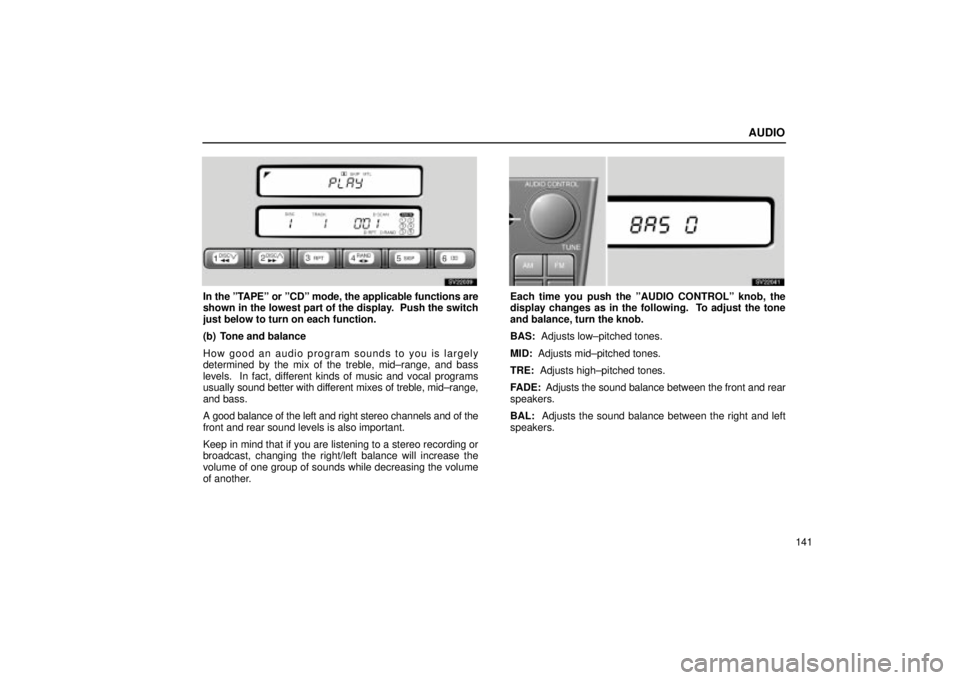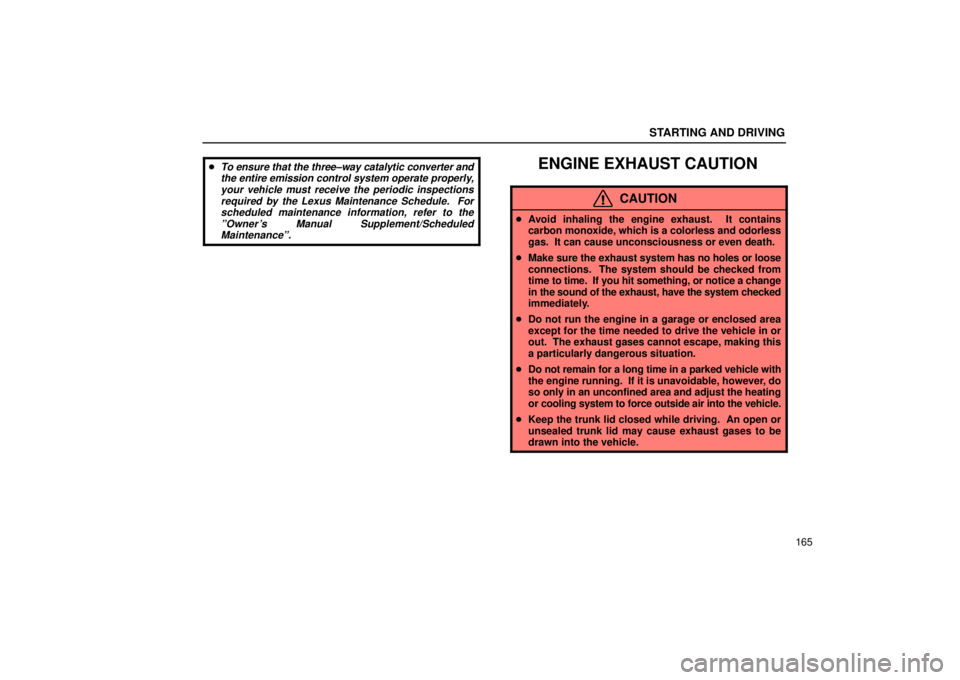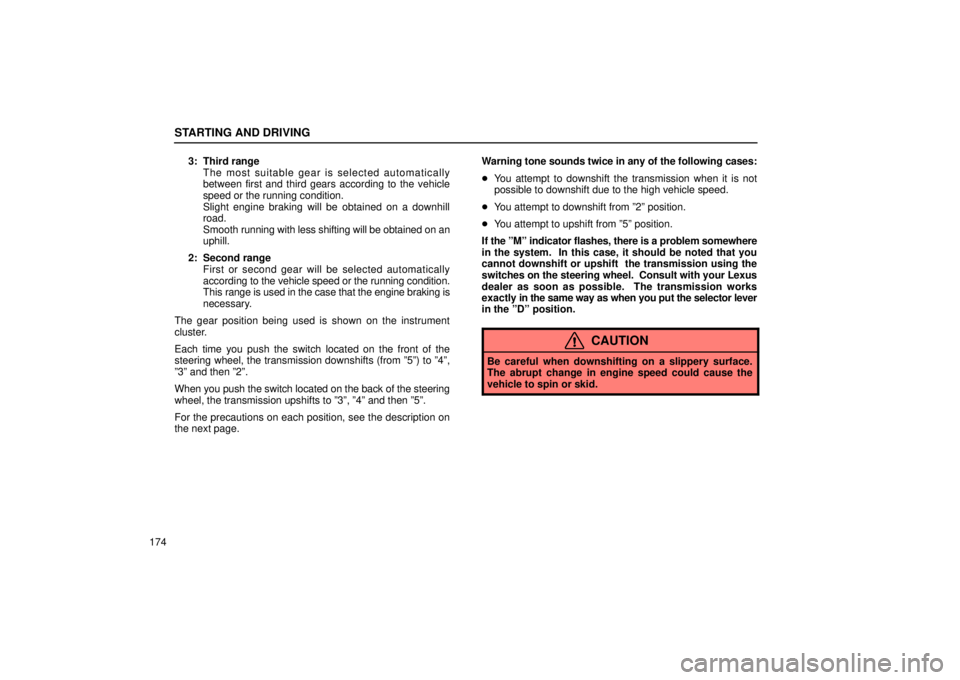Page 154 of 307

AUDIO
141
SV22039
In the ºTAPEº or ºCDº mode, the applicable functions are
shown in the lowest part of the display. Push the switch
just below to turn on each function.
(b) Tone and balance
How good an audio program sounds to you is largely
determined by the mix of the treble, mid±range, and bass
levels. In fact, different kinds of music and vocal programs
usually sound better with different mixes of treble, mid±range,
and bass.
A good balance of the left and right stereo channels and of the
front and rear sound levels is also important.
Keep in mind that if you are listening to a stereo recording or
broadcast, changing the right/left balance will increase the
volume of one group of sounds while decreasing the volume
of another.
SV22041
Each time you push the ºAUDIO CONTROLº knob, the
display changes as in the following. To adjust the tone
and balance, turn the knob.
BAS: Adjusts low±pitched tones.
MID: Adjusts mid±pitched tones.
TRE: Adjusts high±pitched tones.
FADE: Adjusts the sound balance between the front and rear
speakers.
BAL: Adjusts the sound balance between the right and left
speakers.
Page 157 of 307

AUDIO
144(b) Presetting a station
SV22029
1. Tune in the desired station.
2. Push
one of the station selector buttons ( 1±6 ) and hold
it until a beep is heard. This sets the station to the button
and the button number ( 1±6 ) appears on the display.
Each button can store one AM station and two FM stations. To
change the preset station to a different one, follow the same
procedure.
The preset station memory is cancelled when the power
source is interrupted by battery disconnection or a blown fuse. (c) Selecting a station
Your Lexus has an electronic tuning radio (ETR). Tune in the
desired station using one of the following methods.
SV22009
Preset
tuning: Push the button ( 1±6 ) for the station you want.
The button number ( 1±6 ) and station frequency appear on the
display.
Manual tuning: Turn the ºAUDIO CONTROLº knob clockwise
to step up the frequency. Turn the knob counterclockwise to
step down the frequency. (See page 143.)
Seek tuning: Push the ºSEEKº button. The radio will begin
seeking up or down for a station of the nearest frequency and
will stop on reception. Each time you push the button, the
stations will be searched out one after another.
Page 178 of 307

STARTING AND DRIVING
165
�
To ensure that the three±way catalytic converter and
the entire emission control system operate properly,your vehicle must receive the periodic inspectionsrequired by the Lexus Maintenance Schedule. Forscheduled maintenance information, refer to theºOwner's Manual Supplement/ScheduledMaintenanceº.ENGINE EXHAUST CAUTION
CAUTION
� Avoid inhaling the engine exhaust. It contains
carbon monoxide, which is a colorless and odorless
gas. It can cause unconsciousness or even death.
� Make sure the exhaust system has no holes or loose
connections. The system should be checked from
time to time. If you hit something, or notice a change
in the sound of the exhaust, have the system checked
immediately.
� Do not run the engine in a garage or enclosed area
except for the time needed to drive the vehicle in or
out. The exhaust gases cannot escape, making this
a particularly dangerous situation.
� Do not remain for a long time in a parked vehicle with
the engine running. If it is unavoidable, however, do
so only in an unconfined area and adjust the heating
or cooling system to force outside air into the vehicle.
� Keep the trunk lid closed while driving. An open or
unsealed trunk lid may cause exhaust gases to be
drawn into the vehicle.
Page 187 of 307

STARTING AND DRIVING
1743: Third range
The most suitable gear is selected automatically
between first and third gears according to the vehicle
speed or the running condition.
Slight engine braking will be obtained on a downhill
road.
Smooth running with less shifting will be obtained on an
uphill.
2: Second range First or second gear will be selected automatically
according to the vehicle speed or the running condition.
This range is used in the case that the engine braking is
necessary.
The gear position being used is shown on the instrument
cluster.
Each time you push the switch located on the front of the
steering wheel, the transmission downshifts (from º5º) to º4º\
,
º3º and then º2º.
When you push the switch located on the back of the steering
wheel, the transmission upshifts to º3º, º4º and then º5º\
.
For the precautions on each position, see the description on
the next page. Warning tone sounds twice in any of the following cases:
�
You attempt to downshift the transmission when it is not
possible to downshift due to the high vehicle speed.
� You attempt to downshift from º2º position.
� You attempt to upshift from º5º position.
If the ºMº indicator flashes, there is a problem somewhere
in the system. In this case, it should be noted that you
cannot downshift or upshift the transmission using the
switches on the steering wheel. Consult with your Lexus
dealer as soon as possible. The transmission works
exactly in the same way as when you put the selector lever
in the ºDº position.
CAUTION
Be careful when downshifting on a slippery surface.
The abrupt change in engine speed could cause the
vehicle to spin or skid.
Page 238 of 307

MAINTENANCE
225
Automatic transmission ºParkº mechanism
On a safe incline, check that your vehicle is held securely with
the selector lever in ºPº position and all brakes released.
Engine compartment
Items listed below should be checked from time to time,
e.g. each time when refueling.
Washer fluid
Make
sure there is sufficient fluid in the tank. See page 274 for
additional information.
Engine coolant level
Make sure the coolant level is between the Upper and Lower
lines on the see±through reservoir when the engine is cold.
See page 245 for additional information.
Battery
Your Lexus has a maintenance free battery. You do not have
to add distilled water. For longer life of the battery, however,
see page 268 for additional information.
Brake fluid level
Make sure the brake fluid level is correct. See page 252 for
additional information.
Engine oil level
Check the level on the dipstick with the engine turned off and
the vehicle parked on a level spot. See page 242 for additional
information. Power steering fluid level
Check the level on the dipstick. The level should be in the
ºHOTº or ºCOLDº range depending on the fluid temperature.
See page 253 for additional information.
Exhaust system
If you notice any change in the sound of the exhaust or smell
exhaust fumes, have the cause located and corrected
immediately. (See ªEngine exhaust cautionsº on page 165 in
Section 3±1.)
Page 254 of 307

ENGINE
241
The amount of engine oil consumed depends on the
viscosity of the oil, the quality of the oil and the way the
vehicle is driven.
More oil is consumed under driving conditions such as high
speeds and frequent acceleration and deceleration.
A new engine consumes more oil, since its pistons, piston rings
and cylinder walls have not become conditioned.
When judging the amount of oil consumption, keep in
mind that the oil may have become diluted, making it
difficult to judge the true level accurately.
For example, if a vehicle is used for repeated short trips and
consumes a normal amount of oil, the dipstick may not show
any drop in the oil level at all, even after 1000 km (600 miles)
or more. This is because the oil is gradually becoming diluted
with
fuel or moisture, making it appear that the oil level has not
changed.
The diluting ingredients evaporate out when the vehicle is then
driven at high speeds, as on an expressway, making it appear
that oil is excessively consumed after driving at high speeds.
Importance of engine oil level check
One of the most important points in proper vehicle
maintenance is to keep the engine oil at the optimum level so
that oil function will not be impaired. Therefore, it is essential
that the oil level be checked regularly. Lexus recommends that
the oil level be checked every time you refuel the vehicle.
NOTICE
Failure to check the oil level regularly could lead to serious engine trouble due to insufficient oil.
For detailed information on oil level check, see ºChecking the
engine oil levelº on page 242.